
views
Creating a Happy Space
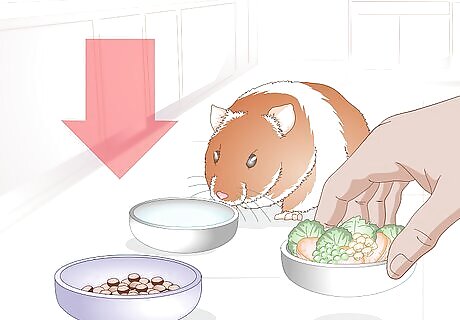
Meet your hamster’s basic needs. The foundation of a happy hamster is a hamster whose basic needs are met. Without basic needs like food, healthcare, and a good home, your hamster will not be happy. Make sure to: Provide good and fresh food. Consider making your own fresh hamster food out of leafy greens, carrots, and other vegetables. Take your hamster to the vet if he or she is ill. Provide chew toys. A rodent's teeth keep growing for life, so they will need some wooden toys to chew on. Teeth that are too long can stop them from eating and kill them. Make sure your hamster’s cage is located in a space that is heated, cooled, and has a constant temperature. An optimal temperature for hamsters range between 70 and 80 degrees Fahrenheit. Avoid temperatures below 60 and above 90 degrees.

Provide your hamster with a large cage. Since your hamster will spend most of his or her life in your cage or container, make sure that the cage is spacious enough so your hamster can move around, exercise, and explore as much as he or she wants. Ultimately, if you coup your hamster up in a tiny enclosure, he or she won’t be happy. Your cage should be a minimum of 2 square feet. Ultimately, though, an enclosure twice this size would be good. Avoid small glass aquariums. The more hamsters you have co-habituating, the larger your enclosure should be.
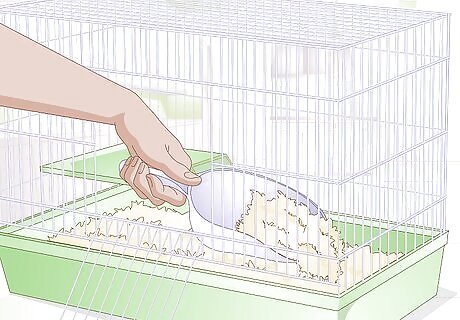
Outfit your hamster enclosure with all of the necessary trappings. Ultimately, a happy hamster needs a happy and interesting environment. If your hamster is wanting for basic items, he or she will not be happy. Make sure to include: Wood shavings or a similar substance to blanket the floor of the cage. Hamsters like to burrow, so make sure there are some areas where the shavings are deep. Avoid cedar or pine wood shavings, as they might be toxic to hamsters. Soft bedding. Make sure there are a couple of areas where you provide your hamster with soft bedding. This could be an old towel, part of an old t-shirt or something similar. A water bottle. A food dish.

Put the cage in a quiet room. Make sure to put your hamster’s cage in a safe and quiet area. Hamsters, like people or other animals, need a safe and quiet area so they can live without anxiety or danger. Make finding a safe and quiet area a priority. Avoid putting your hamster in a place like the kitchen or a family room. A place where the TV is constantly running or people are talking may disturb your hamster and make him or her irritable. Avoid putting your hamster in a place where the family dog or cat can get next to or near the cage. Your cat or dog might stop at nothing to get to your little friend. Avoid putting your hamster where small children can access the cage without supervision. The big danger here is that a small child will allow the hamster to escape.
Providing Entertainment for Your Hamster
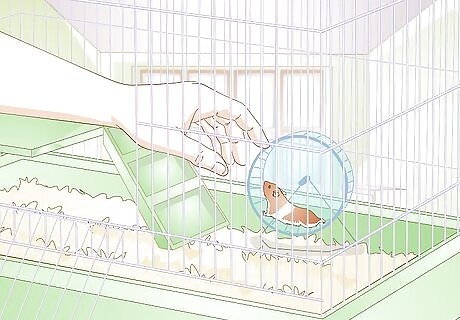
Get your hamster a wheel. Hamster wheels are one of the most popular toys that people get for their hamsters to play with. The best thing about hamster wheels is that it not only provides your hamster with entertainment, but it will also help your hamster exercise and keep fit. Provide one hamster wheel per hamster. Make sure your hamster wheel is the appropriate size for your hamster. As there are different varieties of hamsters, you will want to make sure your hamster does not have a wheel that is too large or too small. Make sure your hamster wheel is properly maintained. Take it out of the cage from time to time. Clean it and service it. If your wheel is rusty, discard it and purchase a new one.
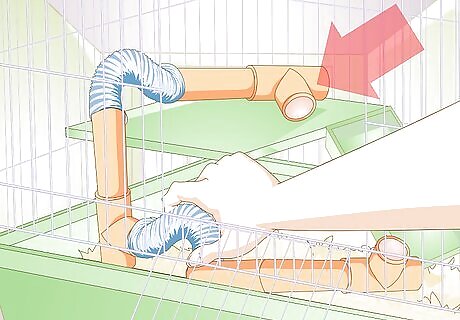
Setup a tube system in your cage, if you have space. One great way to promote hamster happiness is to setup a hamster tube system in your hamster’s cage. A hamster tube system will provide a lot of opportunity for your hamster to play and explore new areas. This will stimulate your hamster’s brain and keep him or her active. Provide an appropriate sized tube system for your cage. Don’t take up the majority of the space with a tube system. You need to leave plenty of room for a hamster wheel, other toys, and more. Change the tube system around every so often. Provide your little friend with opportunities to explore new areas by changing the tube system around. Try to make it so there are cozy places to rest and sleep in the tube system.
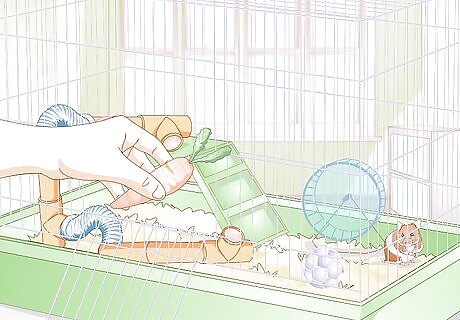
Provide a variety of other hamster toys. While a hamster wheel and a tube system will provide a lot of fun, entertainment, and exercise for your hamster, you should also consider a number of other hamster toys. A variety of toys will keep your hamster busy and entertained. Consider: Cardboard boxes. Boxes are a great place for your friend to hide or play in. Consider constructing a two story hamster house out of tissue boxes. Popsicle sticks. You can fashion a number of hamster toys, like ladders for them to climb, and bridges for them to cross, out of popsicle sticks. Empty toilet paper rolls. These are great for your hamster to crawl through or for them to chew.
Interacting With Your Hamster
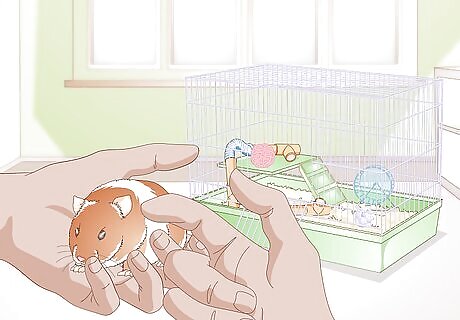
Handle your hamster often. While many hamsters (like Syrians) are solitary animals, they do like companionship, too. Provide your hamster a friend (in yourself) and handle your hamster every couple of days. Handling your hamster often does not have to be a strenuous activity. You can do this simply by holding your hamster gently, allowing him or her to rest in your hand, or allowing them to crawl all over you. Make sure to handle your hamster every day or two. Neglecting your hamster will hurt his or her socialization and affect his or her happiness. If there are days you are unable to handle your hamster, recruit a friend or family member to fill in for you.

Handle your hamster carefully. When handling your hamster, you need to be gentle and handle your friend with care. Being rough with your hamster could injure your friend or cause him or her to be wary of interaction with humans. Do not be rough. Do not handle your hamster in a place where you might drop him or her. Hamsters are very fragile animals and you can easily hurt or kill your friend. Start handling your hamster by introducing your scent to it by putting your hand in his or her cage and cleaning or repositioning toys. Move on to petting your hamster without picking him or her up. When your hamster seems comfortable and does not run away from you, pick him or her up. Always wash your hands before and after you handle your hamster.

Allow your hamster to run around a secure location. Your hamster will probably enjoy getting out of his or her cage every so often and explore new places. If you’re careful, this can be a fun activity for you and your friend. However, consider: Make sure you secure a location in advance so your friend can’t escape. Pay specific attention to making sure your hamster can’t slip under a door, into a vent, or any other opening in the room. Remove all other animals from the room. Remove all poisons or anything that could hurt your little friend. Don’t leave your friend unattended and watch him or her at all times. Note that your hamster might pee or poop in the room. Be prepared to clean it up.

Setup a play date for your hamster. While your hamster might enjoy interacting with you, he or she will probably also enjoy playing with other hamsters. Even if you have two or three of your own, you might consider finding someone else who has hamsters and setting up a play date so the hamsters can play together. Consider: Make sure they play in a neutral location. A good place might be an old and unused cage that is big enough for everyone to play in. Make sure to put toys in the cage. Talk to the owner of the other hamster about health issues. You don’t want your hamster playing with another hamster who might be sick or contagious. If you have a Syrian hamster, don’t set up a play date. Syrians are very territorial. Never leave your hamster unattended with a new hamster. Female hamsters may be more aggressive than males. As a result, you should be careful when allowing females to interact with each other.















Comments
0 comment